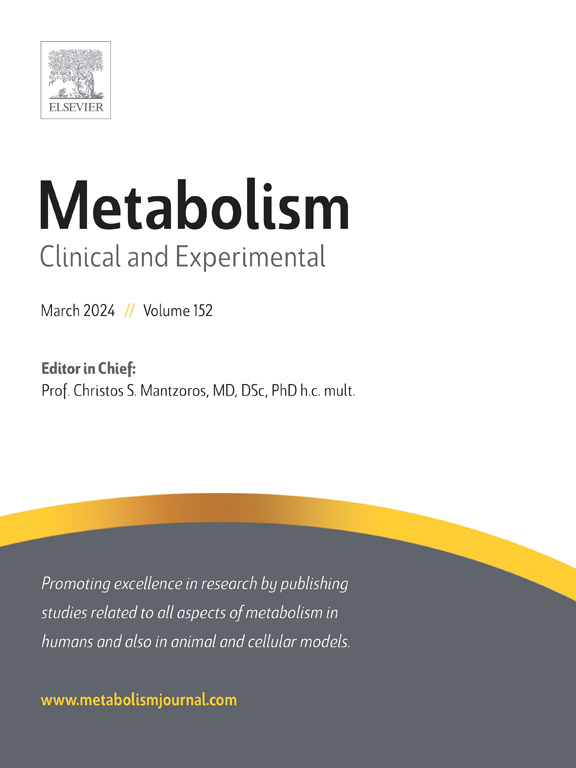TBC1D15通过plin5介导的线粒体与脂滴接触保护雌性小鼠酒精性肝损伤。
IF 11.9
1区 医学
Q1 ENDOCRINOLOGY & METABOLISM
引用次数: 0
摘要
目的:酒精性肝脂肪变性和线粒体功能障碍是促进酒精性肝病(ALD)发展的进行性疾病,通常导致肝硬化和肝细胞癌。TBC1D15是一种Rab7 gtpase激活蛋白(GAP),与线粒体稳态有关,但其在ALD中的作用尚不明确。本研究旨在探讨TBC1D15在ALD中的功能作用,并阐明其潜在机制。方法:将雌性TBC1D15flox/flox小鼠和肝细胞特异性过表达的TBC1D15小鼠饲喂Lieber-DeCarli乙醇饲料,在8 周内逐渐增加乙醇剂量。采用组织学、透射电镜、免疫荧光、免疫印迹和实时PCR技术对肝组织进行评估。结果:暴露于乙醇的人ALD样品和原代肝细胞中TBC1D15水平明显降低。肝细胞特异性TBC1D15过表达可减轻酒精诱导的体重减轻,提高生存率,减轻肝损伤、脂滴(LD)积累和肝细胞凋亡。面对酒精暴露,TBC1D15过表达还通过促进线粒体和ld之间的相互作用来防止酒精诱导的线粒体功能障碍和增强线粒体脂肪酸β氧化(FAO)。在机制上,TBC1D15在酒精暴露下易位到肝细胞的线粒体膜,在那里它通过其10- 180aa结构域招募PLIN5。这种相互作用促进了线粒体- ld接触,促进了pka诱导的PLIN5核易位。此外,TBC1D15在酒精刺激后上调肝细胞中PPARα、PGC1α和CPT1α的蛋白水平,这一作用被PKA抑制所抵消。结论:TBC1D15可能通过与PLIN5的相互作用以及ppa介导的PLIN5核易位调节线粒体- ld接触,从而增强线粒体功能和FAO,从而在ALD损伤中发挥了有希望的保护作用。这些发现确定TBC1D15是ALD的潜在治疗靶点。本文章由计算机程序翻译,如有差异,请以英文原文为准。
TBC1D15 protects alcohol-induced liver injury in female mice through PLIN5-mediated mitochondrial and lipid droplet contacting
Objective
Alcohol-induced hepatic steatosis and mitochondrial dysfunction are progressive conditions contributing to the development of alcoholic liver disease (ALD), often leading to cirrhosis and hepatocellular carcinoma. TBC1D15, a Rab7 GTPase-activating protein (GAP), has been implicated in mitochondrial homeostasis, however, its role in ALD remains elusive. This study aimed to investigate the functional role of TBC1D15 in ALD and elucidate the underlying mechanisms.
Methods
Female TBC1D15flox/flox mice and hepatocyte-specific overexpression of TBC1D15 mice were fed a Lieber-DeCarli ethanol diet, which progressively increasing ethanol dosages over 8 weeks. Liver tissues were assessed using histology, transmission electron microscopy, immunofluorescence, immunoblotting, and real-time PCR techniques.
Results
TBC1D15 levels were markedly decreased in human ALD samples and primary hepatocytes exposed to ethanol. Hepatocyte-specific TBC1D15 overexpression attenuated alcohol-induced body weight loss, improved survival, and alleviated liver injury, lipid droplet (LD) accumulation, and hepatocyte apoptosis. TBC1D15 overexpression also protected against alcohol-induced mitochondrial dysfunction and enhanced mitochondrial fatty acid β-oxidation (FAO) by promoting interactions between mitochondria and LDs in the face of alcohol exposure. Mechanistically, TBC1D15 was translocated to mitochondrial membranes in hepatocytes in response to alcohol exposure, where it recruited PLIN5 through its 10–180 aa domain. This interaction promoted mitochondria-LD contacts and facilitated PKA-induced nuclear translocation of PLIN5. Furthermore, TBC1D15 upregulated protein levels of PPARα, PGC1α and CPT1α in hepatocytes following alcohol challenge, an effect that was nullified by PKA inhibition.
Conclusion
TBC1D15 plays a promising protective role in ALD injury by enhancing mitochondrial function and FAO, potentially through its interaction with PLIN5 and modulation of mitochondria-LD contacts via PKA-mediated nuclear translocation of PLIN5. These findings identify TBC1D15 as a potential therapeutic target for ALD.
求助全文
通过发布文献求助,成功后即可免费获取论文全文。
去求助
来源期刊

Metabolism: clinical and experimental
医学-内分泌学与代谢
CiteScore
18.90
自引率
3.10%
发文量
310
审稿时长
16 days
期刊介绍:
Metabolism upholds research excellence by disseminating high-quality original research, reviews, editorials, and commentaries covering all facets of human metabolism.
Consideration for publication in Metabolism extends to studies in humans, animal, and cellular models, with a particular emphasis on work demonstrating strong translational potential.
The journal addresses a range of topics, including:
- Energy Expenditure and Obesity
- Metabolic Syndrome, Prediabetes, and Diabetes
- Nutrition, Exercise, and the Environment
- Genetics and Genomics, Proteomics, and Metabolomics
- Carbohydrate, Lipid, and Protein Metabolism
- Endocrinology and Hypertension
- Mineral and Bone Metabolism
- Cardiovascular Diseases and Malignancies
- Inflammation in metabolism and immunometabolism
 求助内容:
求助内容: 应助结果提醒方式:
应助结果提醒方式:


